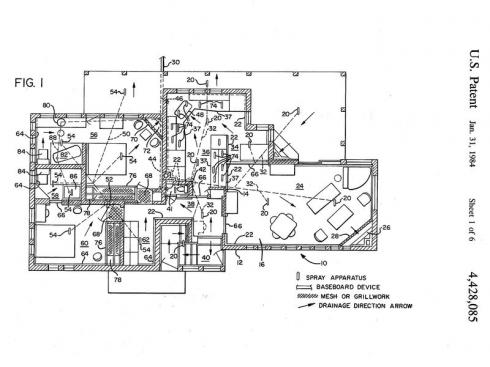
First Self-Cleaning Home
By Ben Panko
Frances Gabe had had enough. It was the late 1970s, and the single mother of two was sick and tired of the scrubbing and cleaning her house. When a stain of fig jam appeared on her wall one day, she put her foot down.
″I thought, darn it, this is more than I can handle,″ Gabe told Patricia Leigh Brown of the New York Times in 2002. ″So I brought out the hose.″
Unconventional? Sure. But it put Gabe, whose death was first reported nationally this week by Margalit Fox of the New York Times, on the path to inventing the first “self-cleaning home.”
The daughter of an architect, Gabe, an inventor and artist, spent more than a decade and thousands of dollars of her life savings revamping her modest Oregon home into “essentially, a giant floor-to-ceiling dishwasher,” as Matthew Korfhage put it for the local Willamette Week in 2013.
In practice, that amounted to inventing 68 separate devices to eliminate every part of the cleaning of the home. There was a cupboard that could clean dishes without needing to move them, and cabinets in which one could hang dirty clothes to be washed and dried that could later be pulled with chains into the closet.
Every room contained sprinklers in the ceiling that sprayed soap and water in circular motion, which would land on floors coated with waterproof varnish. Well-placed drains and hot-air vents helped dry things afterward, while resin, waterproof fabric and awnings protected the furniture and accouterments of the house. Even books and papers were stored in waterproof jackets and plastic boxes for protection.
One of the papers framed in plastic wrap on Gabe’s living room wall was the patent she received in 1984 for “self-cleaning building construction.” Gabe hoped her invention would inspire a new form of self-cleaning building construction, and she toured the country lecturing with a model of her home design.
But her grand idea to end the drudgeries of housework never took hold, and by 2002, the cost of running the house had bled her savings dry. She was unable to pay to renew her patents, and they lapsed. Meanwhile, over the years, natural disasters, such as earthquakes, had also damaged the home.
By the time artist Lily Benson, who made an animation of how the house could ideally work, paid the house a visit in 2007, she told Fox that the house had fallen into a state of disrepair. “It was cluttered and hazardous, which made it difficult to believe that the home had ever been a working invention, Benson later recounted.
In 2009, Gabe’s grandchildren made her move into a retirement home. Her death in December 2016 went unreported outside of her Oregon town. Today, most of the self-cleaning features of Gabe’s home have been dismantled, according to the Korfage in a separate article for the Willamette Week.
But though Gabe was the only person to have lived in a “self-cleaning home,” her vision for the future of housekeeping will not be forgotten.
“Gabe was ridiculed for even attempting the impossible, but architects and builders now admit that her house is functional and attractive,” as Judy Wajcman, professor of sociology at London School of Economics, wrote in 1991. (She added, “One cannot help speculating that the development of an effective self-cleaning house has not been high on the agenda of male engineers.”)
Gabe put her life’s work into trying to create a design that could help women worldwide as well as people who were unable to clean to stay in their homes. During her life, the world might not have been ready to embrace Gabe’s dream for the future, but the inventor never let that stop her on her quest for a self-cleaning home revolutio n.
Source:Smart News
